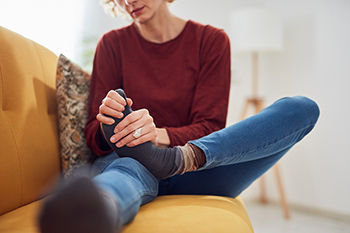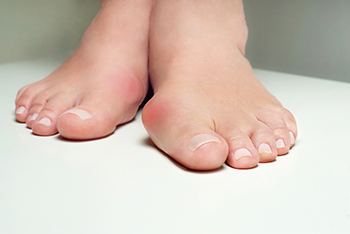Stuart (772) 223-8313Rate Us
Jupiter (561) 744-6683Rate Us
Stuart (772) 223-8313Rate Us
Jupiter (561) 744-6683Rate Us

Walking and running activities might seem similar to many different individuals. Both activities involve the movement of feet and motion. However, despite their similarities, walking and running are extremely different. As a result, both activities require significantly different kinds of shoes, and one shoe will not necessarily work with the other activity. There are many different reasons to help explain this. Importantly, individuals use different strike patterns when they are walking versus running. When running, the feet will strike with the heel, but not necessarily immediately roll forward onto the toes. This is not the case with walking. Additionally, running puts more force from the body's weight onto the feet when compared to walking. Consequently, both running and walking require different things in shoes tailored for that activity. If you are interested in learning more about walking and running shoes, contact a podiatrist today.
For more information about walking shoes versus running shoes, consult with one of our podiatrists from Advanced Foot & Ankle Specialists, PA. Our doctors can measure your feet to determine what your needs are and help you find an appropriate pair of footwear.
Foot Health: The Differences between Walking & Running Shoes
There are great ways to stay in shape: running and walking are two great exercises to a healthy lifestyle. It is important to know that running shoes and walking shoes are not interchangeable. There is a key difference on how the feet hit the ground when someone is running or walking. This is why one should be aware that a shoe is designed differently for each activity.
You may be asking yourself what the real differences are between walking and running shoes and the answers may shock you.
Differences
Walking doesn’t involve as much stress or impact on the feet as running does. However, this doesn’t mean that you should be any less prepared. When you’re walking, you land on your heels and have your foot roll forward. This rolling motion requires additional support to the feet.
Flexibility – Walking shoes are designed to have soft, flexible soles. This allows the walker to push off easily with each step.
If you have any questions, please feel free to contact one of our offices located in Stuart and Jupiter, FL . We offer the newest diagnostic and treatment technologies for all your foot care needs.

The foot condition known as athlete’s foot is quite common, and it is considered to be contagious. Many people may notice symptoms but choose to ignore them until they become severe. These symptoms can include itchiness between the toes, redness, and flaky patches that may develop on various parts of the foot. In severe cases, small blisters may form and this can cause discomfort. Athlete’s foot is caused by a fungus that lives in moist areas like public swimming pools and locker rooms. Effective prevention methods are refraining from sharing shoes, towels, and socks. Wearing appropriate shoes is advised while in these types of environments. Research has shown that athlete’s foot will not improve without treatment and it is strongly urged that you are under the care of a podiatrist if you are afflicted with this condition.
Athlete’s foot is an inconvenient condition that can be easily reduced with the proper treatment. If you have any concerns about your feet and ankles, contact one of our podiatrists from Advanced Foot & Ankle Specialists, PA. Our doctors will treat your foot and ankle needs.
Athlete’s Foot: The Sole Story
Athlete's foot, also known as tinea pedis, can be an extremely contagious foot infection. It is commonly contracted in public changing areas and bathrooms, dormitory style living quarters, around locker rooms and public swimming pools, or anywhere your feet often come into contact with other people.
Solutions to Combat Athlete’s Foot
Athlete’s foot can cause many irritating symptoms such as dry and flaking skin, itching, and redness. Some more severe symptoms can include bleeding and cracked skin, intense itching and burning, and even pain when walking. In the worst cases, Athlete’s foot can cause blistering as well. Speak to your podiatrist for a better understanding of the different causes of Athlete’s foot, as well as help in determining which treatment options are best for you.
If you have any questions please feel free to contact one of our offices located in Stuart and Jupiter, FL . We offer the newest diagnostic and treatment technologies for all your foot and ankle needs.

The feet provide shock absorption to the body, and foot pain is often difficult to ignore. Research has shown that approximately 75 percent of people across the country will have some type of foot pain at different points in their lives. There are various reasons why foot pain can occur, including wearing shoes that do not fit correctly, and poor foot function and pain have been linked to obesity. Additionally, the feet can change as the aging process occurs, possibly causing the connective tissue to loosen, which may cause pain and discomfort. Specific medical conditions can cause foot pain, consisting of bunions, ingrown toenails, and Achilles tendonitis. Patients who are afflicted with a broken foot, plantar warts, or gout may experience foot pain, and prompt medical attention is often sought. There are many reasons to have this type of pain, and it is important that the cause is determined, which is followed by beginning the correct treatment. Mild treatment techniques can include wearing cushioned shoes, massaging the feet, and frequently elevating the affected foot. If you have foot pain for any reason, it is strongly urged that you are under the care of a podiatrist who can effectively determine the reason why, and offer the treatment option that is right for you.
Foot Pain
Foot pain can be extremely painful and debilitating. If you have a foot pain, consult with one of our podiatrists from Advanced Foot & Ankle Specialists, PA. Our doctors will assess your condition and provide you with quality foot and ankle treatment.
Causes
Foot pain is a very broad condition that could be caused by one or more ailments. The most common include:
Diagnosis
To figure out the cause of foot pain, podiatrists utilize several different methods. This can range from simple visual inspections and sensation tests to X-rays and MRI scans. Prior medical history, family medical history, and any recent physical traumatic events will all be taken into consideration for a proper diagnosis.
Treatment
Treatment depends upon the cause of the foot pain. Whether it is resting, staying off the foot, or having surgery; podiatrists have a number of treatment options available for foot pain.
If you have any questions, please feel free to contact one of our offices located in Stuart and Jupiter, FL . We offer the newest diagnostic and treatment technologies for all your foot care needs.

A bunion is recognized as a hard bump that forms on the outside of the big toe. It develops as a bony protrusion, and it is considered to be a deformity. Genetics may contribute to getting a bunion, in addition to wearing shoes that do not have adequate room for the toes to move freely. This may be a reason why bunions are more common among women, and relief may be found when appropriate-size shoes are worn. A bunion can put pressure on the other toes and may cause them to shift towards each other. Additionally, a corn or callus may form on top of the bunion, which may happen from the toes touching the top of the shoe. Other symptoms may consist of joint pain, and the toes may have a limited range of motion. A bunion may stop growing when larger shoes are worn, and temporary relief may be found when protective pads are worn over it. If you have developed a bunion, it is strongly urged that you consult with a podiatrist who can offer correct treatment options, which may include surgery for permanent removal.
If you are suffering from bunions, contact one of our podiatrists of Advanced Foot & Ankle Specialists, PA. Our doctors can provide the care you need to keep you pain-free and on your feet.
What Is a Bunion?
A bunion is formed of swollen tissue or an enlargement of boney growth, usually located at the base joint of the toe that connects to the foot. The swelling occurs due to the bones in the big toe shifting inward, which impacts the other toes of the foot. This causes the area around the base of the big toe to become inflamed and painful.
Why Do Bunions Form?
Genetics – Susceptibility to bunions are often hereditary
Stress on the feet – Poorly fitted and uncomfortable footwear that places stress on feet, such as heels, can worsen existing bunions
How Are Bunions Diagnosed?
Doctors often perform two tests – blood tests and x-rays – when trying to diagnose bunions, especially in the early stages of development. Blood tests help determine if the foot pain is being caused by something else, such as arthritis, while x-rays provide a clear picture of your bone structure to your doctor.
How Are Bunions Treated?
If you have any questions, please feel free to contact one of our offices located in Stuart and Jupiter, FL . We offer the newest diagnostic and treatment technologies for all your foot care needs.

A common reason why blisters develop on the feet is friction. Wearing shoes that are too tight may result in excessive rubbing, causing blisters to develop on various parts of the feet. A blister is a small bubble that is filled with liquid, which protects the damaged skin. When new skin has formed underneath it, the blister will gradually drain. It is the body’s natural defense in protecting the skin, and it is important to refrain from prematurely popping it. An additional reason why blisters may form can include frostbite, causing tissue damage. There are various stages of frostbite, and blisters generally form in the second stage. Some people can develop blisters from an allergic reaction, or medical issues consisting of eczema, psoriasis, or shingles. If you have developed one or more blisters on your feet, please contact a podiatrist who can help you with treatment and discuss prevention methods with you.
Blisters are prone to making everyday activities extremely uncomfortable. If your feet are hurting, contact one of our podiatrists of Advanced Foot & Ankle Specialists, PA. Our doctors can provide the care you need to keep you pain-free and on your feet.
Foot Blisters
Foot blisters develop as a result of constantly wearing tight or ill-fitting footwear. This happens due to the constant rubbing from the shoe, which can often lead to pain.
What Are Foot Blisters?
A foot blister is a small fluid-filled pocket that forms on the upper-most layer of the skin. Blisters are filled with clear fluid and can lead to blood drainage or pus if the area becomes infected.
How Do Blisters Form?
Blisters on the feet are often the result of constant friction of skin and material, usually by shoe rubbing. Walking in sandals, boots, or shoes that don’t fit properly for long periods of time can result in a blister. Having consistent foot moisture and humidity can easily lead to blister formation.
Prevention & Treatment
It is important to properly care for the affected area in order to prevent infection and ease the pain. Do not lance the blister and use a Band-Aid to provide pain relief. Also, be sure to keep your feet dry and wear proper fitting shoes. If you see blood or pus in a blister, seek assistance from a podiatrist.
If you have any questions, please feel free to contact one of our offices located in Stuart and Jupiter, FL . We offer the newest diagnostic and treatment technologies for all your foot care needs.